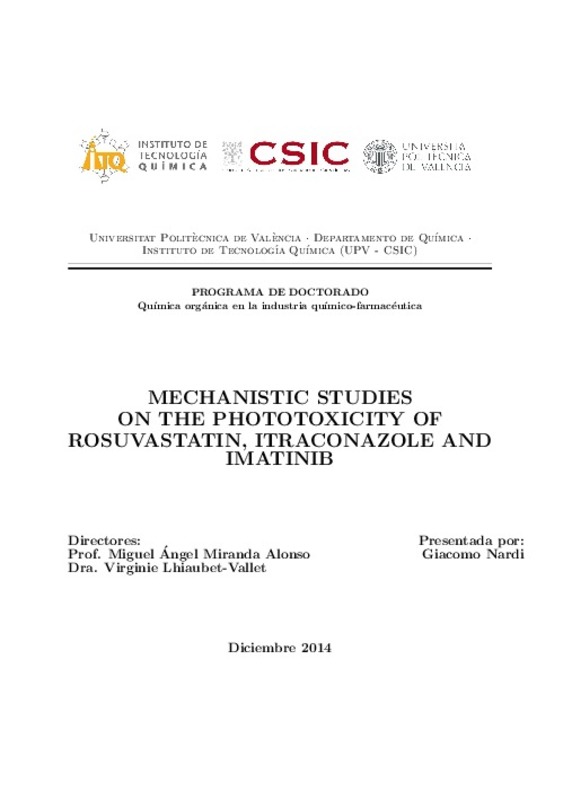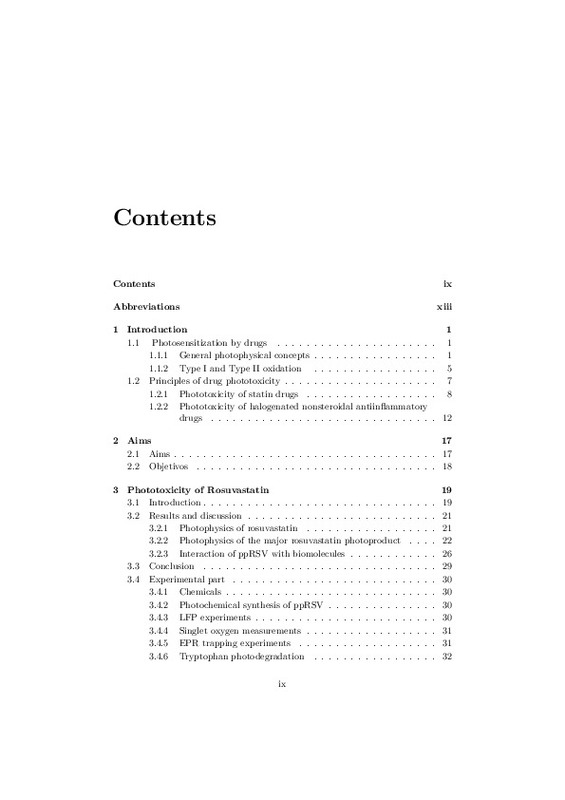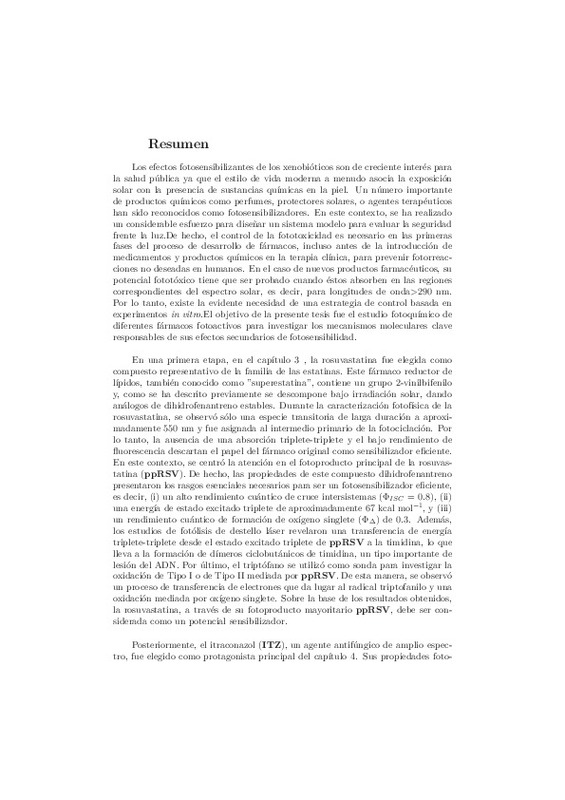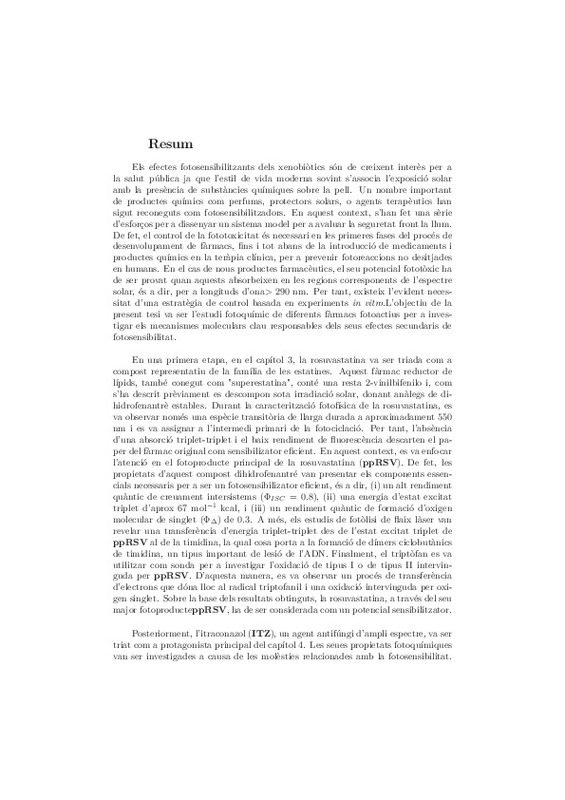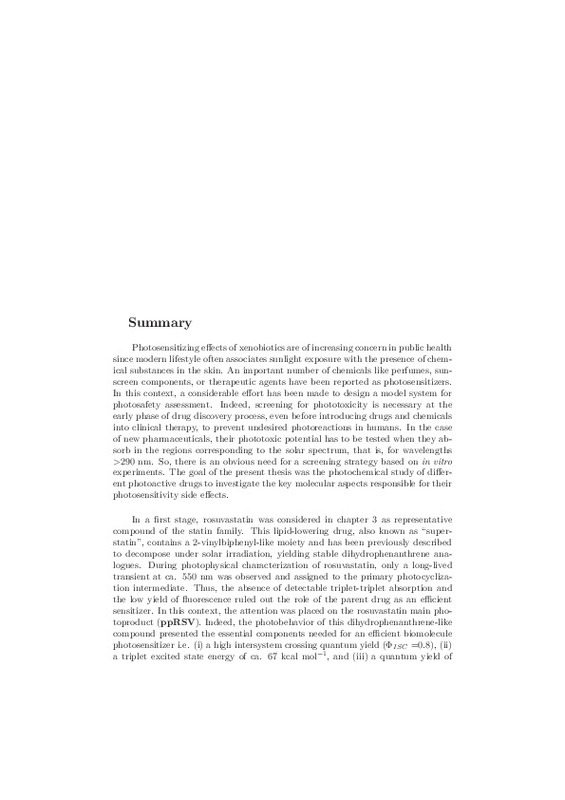- RiuNet repositorio UPV
- :
- Investigación
- :
- Tesis doctorales
- :
- Ver ítem
JavaScript is disabled for your browser. Some features of this site may not work without it.
Buscar en RiuNet
Listar
Mi cuenta
Estadísticas
Ayuda RiuNet
Admin. UPV
MECHANISTIC STUDIES ON THE PHOTOTOXICITY OF ROSUVASTATIN, ITRACONAZOLE AND IMATINIB
Mostrar el registro sencillo del ítem
Ficheros en el ítem
| dc.contributor.advisor | Lhiaubet, Virginie Lyria
|
es_ES |
| dc.contributor.advisor | Miranda Alonso, Miguel Ángel
|
es_ES |
| dc.contributor.author | Nardi, Giacomo
|
es_ES |
| dc.date.accessioned | 2015-03-31T06:02:29Z | |
| dc.date.available | 2015-03-31T06:02:29Z | |
| dc.date.created | 2014-12-22 | es_ES |
| dc.date.issued | 2015-03-31 | es_ES |
| dc.identifier.uri | http://hdl.handle.net/10251/48535 | |
| dc.description.abstract | Photosensitizing effects of xenobiotics are of increasing concern in public health since modern lifestyle often associates sunlight exposure with the presence of chemical substances in the skin. An important number of chemicals like perfumes, sunscreen components, or therapeutic agents have been reported as photosensitizers. In this context, a considerable effort has been made to design a model system for photosafety assessment. Indeed, screening for phototoxicity is necessary at the early phase of drug discovery process, even before introducing drugs and chemicals into clinical therapy, to prevent undesired photoreactions in humans. In the case of new pharmaceuticals, their phototoxic potential has to be tested when they absorb in the regions corresponding to the solar spectrum, that is, for wavelengths >290 nm. So, there is an obvious need for a screening strategy based on in vitro experiments. The goal of the present thesis was the photochemical study of different photoactive drugs to investigate the key molecular aspects responsible for their photosensitivity side effects. In a first stage, rosuvastatin was considered in chapter 3 as representative compound of the statin family. This lipid-lowering drug, also known as “superstatin”, contains a 2-vinylbiphenyl-like moiety and has been previously described to decompose under solar irradiation, yielding stable dihydrophenanthrene analogues. During photophysical characterization of rosuvastatin, only a long-lived transient at ca. 550 nm was observed and assigned to the primary photocyclization intermediate. Thus, the absence of detectable triplet-triplet absorption and the low yield of fluorescence ruled out the role of the parent drug as an efficient sensitizer. In this context, the attention was placed on the rosuvastatin main photoproduct (ppRSV). Indeed, the photobehavior of this dihydrophenanthrene-like compound presented the essential components needed for an efficient biomolecule photosensitizer i.e. (i) a high intersystem crossing quantum yield (ΦISC =0.8), (ii) a triplet excited state energy of ca. 67 kcal mol−1 , and (iii) a quantum yield of singlet oxygen formation (Φ∆) of 0.3. Furthermore, laser flash photolysis studies revealed a triplet-triplet energy transfer from the triplet excited state of ppRSV to thymidine, leading to the formation of cyclobutane thymidine dimers, an important type of DNA lesion. Finally, tryptophan was used as a probe to investigate the Type I and/or Type II character of ppRSV-mediated oxidation. In this way, both an electron transfer process giving rise to the tryptophanyl radical and a singlet oxygen mediated oxidation were observed. On the basis of the obtained results, rosuvastatin, through its major photoproduct ppRSV, should be considered as a potential sensitizer. Then, itraconazole (ITZ), a broad-spectrum antifungal agent, was chosen as main character of chapter 4. Its photochemical properties were investigated in connection with its reported skin photosensitivity disorders. Steady state photolysis, fluorescence and phosphorescence experiments were performed to understand ITZ photoreactivity in biological media. The drug is unstable under UVB irradiation, suffering a primary dehalogenation of the 2,4-dichlorophenyl moiety that occurs mainly at the ortho-position. In poorly H-donating solvents, as acetonitrile, the major photoproduct arises from intramolecular attack of the initially generated aryl radical to the triazole ring. In addition, reduced compounds resulting from homolytic cleavage of the C-Cl bond in ortho or para positions and subsequent Habstraction from the medium are obtained to a lesser extent. In good H-donating solvents, such as ethanol, the main photoproducts are formed by reductive dehalogenation. Furthermore, irradiation of a model dyad containing a tryptophan unit and the reactive 2,4-dichlorophenyl moiety of itraconazole leads to formation of a new covalent link between these two substructures revealing that homolysis of the C-Cl bond of ITZ can result in alkylation of reactive amino acid residues of proteins, leading to formation of covalent photoadducts. Therefore, it has been established that the key process in the photosensitization by itraconazole is cleavage of the carbon-halogen bond, which leads to aryl radicals and chlorine atoms. These highly reactive species might be responsible for extensive free radical-mediated biological damage, including lipid peroxidation or photobinding to proteins. In chapter 5, photobehavior of imatinib (IMT) was addressed. This is a promising tyrosine kinase inhibitor used in the treatment of some types of human cancer, which constitutes a successful example of rational drug design based on the optimization of the chemical structure to reach an improved pharmacological activity. Cutaneous reactions, such as increased photosensitivity or pseudoporphyria, are among the most common nonhematological IMT side effects; however, the molecular bases of these clinical observations have not been unveiled yet. Thus, to gain insight into the IMT photosensitizing properties, its photobehavior was studied together with that of its potentially photoactive anilino-pyrimidine and pyridyl-pyrimidine fragments. In this context, steady-state and time resolved fluorescence, as well as laser flash photolysis experiments were run, and the DNA photosensitization potential was investigated by means of single strand breaks detection using agarose gel electrophoresis. The obtained results revealed that the drug itself and its anilino-pyrimidine fragment are not DNA-photosensitizers. By contrast, the pyridyl-pyrimidine substructure displayed a marked photogenotoxic potential, which was associated with the generation of a long-lived triplet excited state. Interestingly, this reactive species was efficiently quenched by benzanilide, another molecular fragment of IMT. Clearly, integration of the photoactive pyridyl-pyrimidine moiety in a more complex structure strongly modifies its photobehavior, which in this case is fortunate as it leads to an improved toxicological profile. Thus, on the bases of the experimental results, direct in vivo photosensitization by IMT seems unlikely. Instead, the reported photosensitivity disorders could be related to indirect processes, such as the previously suggested impairment of melanogenesis or the accumulation of endogenous porphyrins. Finally, a possible source of errors in the TEMPO/EPR method for singlet oxygen detection was analyzed. For many biological and biomedical studies, it is essential to detect the production of 1O2 and to quantify its production yield. Among the available methods, detection of the characteristic 1270 nm phosphorescence of singlet oxygen by time-resolved near infrared (TRNIR) emission constitutes the most direct and unambiguous approach. An alternative indirect method is electron paramagnetic resonance (EPR) in combination with trapping. This is based on the detection of the TEMPO free radical formed after oxidation of TEMP (2,2,6,6- tetramethylpiperidine) by singlet oxygen. Although the TEMPO/EPR method has been largely employed, it can produce misleading data. This was demonstrated by the present study, where the quantum yields of singlet oxygen formation obtained by TRNIR emission and by the TEMPO/EPR method were compared for a set of well-known photosensitizers. The results revealed that the TEMPO/EPR method leads to significant overestimation of singlet oxygen yield when the singlet or triplet excited state of the photosensitizers were efficiently quenched by TEMP, acting as electron donor. In such case, generation of the TEMP+• radical cation, followed by deprotonation and reaction with molecular oxygen gives rise to a EPR detectable TEMPO signal that is not associated with singlet oxygen production. This knowledge is essential for an appropriate and error-free application of the TEMPO/EPR method in chemical, biological and medical studies. | en_EN |
| dc.language | Inglés | es_ES |
| dc.publisher | Universitat Politècnica de València | es_ES |
| dc.rights | Reserva de todos los derechos | es_ES |
| dc.subject | Photosensitizing effects | es_ES |
| dc.subject | Photosensitizers | |
| dc.subject | Photosafety assessment | |
| dc.subject | Phototoxicity | |
| dc.subject | Photoactive drugs | |
| dc.subject | Photosensitivity | |
| dc.subject | Rosuvastatin | |
| dc.subject | Triplet-triplet energy transfer | |
| dc.subject | Triplet excited state | |
| dc.subject | Photoproduct | |
| dc.subject | Fluorescence | |
| dc.subject | Thymidine | |
| dc.subject | Cyclobutane thymidine dimers | |
| dc.subject | Tryptophan itraconazole | |
| dc.subject | Phosphorescence | |
| dc.subject | Photosensitivity disorders | |
| dc.subject | Dehalogenation | |
| dc.subject | Model dyad | |
| dc.subject | Radicals | |
| dc.subject | Matinib | |
| dc.subject | Cutaneous reactions | |
| dc.subject | Electrophoresis | |
| dc.subject | Laser flash photolysis | |
| dc.subject.classification | QUIMICA ORGANICA | es_ES |
| dc.title | MECHANISTIC STUDIES ON THE PHOTOTOXICITY OF ROSUVASTATIN, ITRACONAZOLE AND IMATINIB | es_ES |
| dc.type | Tesis doctoral | es_ES |
| dc.identifier.doi | 10.4995/Thesis/10251/48535 | es_ES |
| dc.rights.accessRights | Abierto | es_ES |
| dc.contributor.affiliation | Universitat Politècnica de València. Departamento de Química - Departament de Química | es_ES |
| dc.description.bibliographicCitation | Nardi, G. (2014). MECHANISTIC STUDIES ON THE PHOTOTOXICITY OF ROSUVASTATIN, ITRACONAZOLE AND IMATINIB [Tesis doctoral no publicada]. Universitat Politècnica de València. https://doi.org/10.4995/Thesis/10251/48535 | es_ES |
| dc.description.accrualMethod | TESIS | es_ES |
| dc.type.version | info:eu-repo/semantics/acceptedVersion | es_ES |
| dc.relation.pasarela | TESIS\7961 | es_ES |
Este ítem aparece en la(s) siguiente(s) colección(ones)
-
Tesis doctorales [5284]






